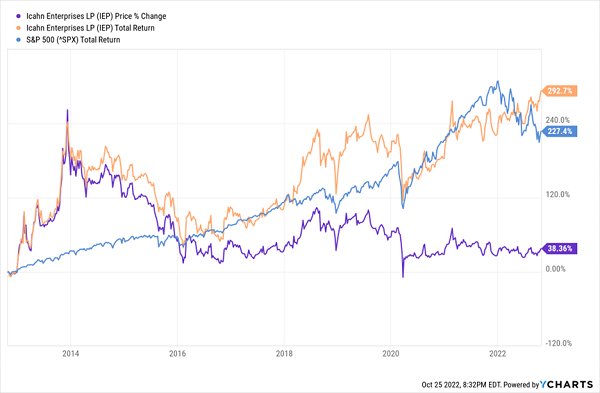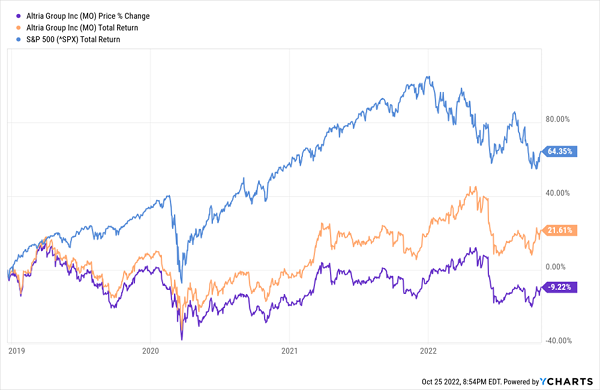Vanilla investors are selling. Which means we income-focused contrarians are buying.
Our goal, after all, is to retire on dividends. So why would we run from the biggest dividends that Mr. and Ms. Market have presented us in years?
Yields, yields, yields. We recently discussed 29 income funds yielding more than 8%.
How about stocks? Glad you asked. Let’s chat about 16 sweet large-cap cash-machine stocks paying up to 15%.
If you didn’t catch it, I recently chatted with Moe Ansari on his Market Wrap program. You can read more about it here, but in short, I said the time to sell was over—we’re flush with cash and ready to buy.

But we’re not buying just anything. We’re purchasing with purpose: To fund a retirement plan paid solely with cash dividends and interest income.
You can’t do that with meager yields. Yes, Treasuries are finally making things interesting now that the 10-year dishes 4%. But we still need more—much more.
We generally want stocks yielding at least 7%. This lets us reap a $70,000 annual “salary” from a million-dollar nest egg, and a still substantial sum even if you have a smaller amount to invest with.
We have plenty of candidates right now—396 to be specific!
Nearly 400 Monster Yields Right Now

Note: U.S.-listed companies and funds with market capitalizations or AUM greater than $300 million Source: S&P Global Market Intelligence
Is it better to focus on bigger stocks? Let’s get to those 16 large-cap stocks yielding between 7.1% and 14.9%. First, a quick look at the full list, then I’m going to highlight a few names that stick out for one reason or another. Some of them are intriguing. Others, however, are potential dividend dogs (read: avoid).

Energy
The most obvious and noteworthy cluster of stocks on here are energy stocks, which account for 11 of the 16 names on the list.
Some of these are traditional E&P players such as Devon Energy (DVN, 8.4% yield) and Diamondback Energy (FANG, 8.0% yield). Their prices will always be firmly latched to the price of oil, but that’s paid off in 2022, with the sector up nearly 60% year-to-date. And yet many yields remain sky-high—DVN and FANG yield 8%-plus despite respective gains of 72% and 42%.
Just note that while no yield is locked in stone, some of these payouts warrant a closer eye than others. Chesapeake Energy (CHK), for instance, is paying a base dividend of just 55 cents per share—good for a 2.2% yield at current prices. The rest of that 7.4%-plus yield is coming via variable dividends dependent on cash flow. The yields of Coterra Energy (CTRA, 8.8% yield) and Pioneer Natural Resources (PXD, 13.00%) reflect special dividends, too.
That’s prudent cash management for firms that have watched oil prices swing wildly over the past few years. But we should be equally as prudent when it comes to relying on these kinds of payouts for retirement.
The bigger chunk of energy names are master limited partnerships (MLPs) such as Enterprise Products Partners LP (EPD) and Energy Transfer LP (ET), both of which yield 7.6%. These payouts have by and large been more stable than E&Ps, but remember: They’re a headache come tax time, requiring the dreaded K-1 form.
Icahn Enterprises LP
Speaking of MLPs, the highest yielder of the group is Icahn Enterprises LP (IEP, 14.9% yield), which is the holding company for legendary investor Carl Icahn.
If you do choose to own IEP, try to ignore the price returns in your brokerage account—they’re historically terrible. This is a pure yield play, with the distribution accounting for 85% of performance over the past decade.
Icahn Does the Talking, Dividends Do Most of the Walking

VF Corp
VF Corp (VFC, 7.2% yield) is the name behind apparel brands including Vans, North Face, Timberland and Supreme. And business in 2022 has been difficult, to put it mildly. In late September, the company provided an optimistic five-year outlook but lowered their 2023 guidance. Vans, their largest brand, is facing numerous challenges, and the company doesn’t have much in the way of resources to ignite growth given high debt and. Still, the stock price hasn’t been this low since 2011, shares trade for a thin 10 times next year’s earnings, and the yield hasn’t been this high since the 1990s. This could be an enticing (albeit risky) income-and-eventual-growth play for investors playing the really long game.
Verizon Communications
Also struggling this year has been Verizon Communications (VZ, 7.4% yield), which at 30% declines in 2022 has not fulfilled its traditionally defensive role. An earnings miss and guidance reduction are partly to blame, as is the utter lack of a growth catalyst. Verizon did raise prices on consumers this year, but that was mostly to offset what CEO Hans Vestberg says will be the company’s “peak year” in infrastructure investment, estimating $22 billion in capex. But that 7.4% dividend is quite sturdy, at just 56% of profits, and VZ’s forward-looking price-to-earnings ratio has sunk to below 7.
Altria Group
Marlboro parent Altria Group’s (MO, 8.5% yield) made a massive $12.8 billion investment in e-cigarette maker Juul—a move that was largely expected to launch the dependable high-yielding dividend payer into growth mode.
Not so much.
Altria Hasn’t Been Able to Catch Fire

MO shares have been listless over the past few years as its Juul investment has gone up in smoke. U.S. regulators have gone after e-cigarettes, and the FDA this summer briefly banned Juul specifically before issuing a stay on its own order while it continues to review the product.
As a result of all this chaos, Altria has repeatedly written down the value of its Juul stake, which sat at $450 million as of late July.
Still, my colleague Jeff Reeves points out that this “antifragile stock” remains a well-managed income investment that could be a contrarian value play in disguise. It has certainly been a source of defense in 2022, up a couple percent on a total-return basis versus roughly 20% declines for the broader market.
How to Lock Up $76K in Annual Income
While large-cap stocks typically are considered the safest plays on Wall Street, many of these high yielders—the products of wild price swings over the past few years—could be set to deliver more nausea for shareholders.
Me? I prefer a smoother path to retirement riches.
And the only way to do that is to value high quality every bit as much as high yields.
That’s why I feel comfortable with the high-quality stocks and funds in my Contrarian Income Report portfolio, which yield an average of 7.6%. In other words, we’re spinning off $76,000 for every million dollars invested.
Not a bad cash companion!
And you don’t have to be a millionaire to take advantage of this strategy. A $500K nest egg will create $38,000 in annual income. Or $200K will generate $15,200 in yearly dividend income. And that’s hard to find.
The important thing is that these yields are safe, which creates stability for the stock (and fund) prices attached to them. We want our income, with our principal intact. It’s really the only way to retire comfortably, without having to stare at stock tickers all day, every day. Sound good?
Best of all, many of my favorite dividends are paid monthly. So, we’re talking about $3,000+ in dividends every month on that $500K. Or $6,000+ per month in income on the seven-figure accounts that Fidelity brags about in its ads.
Click here and I’ll share my favorite 7%+ dividends—dividends that are being paid monthly to boot!


Recent Comments